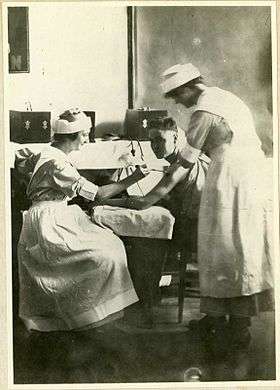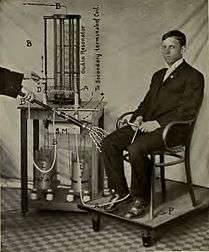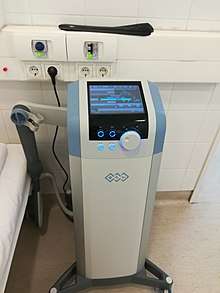Electrotherapy
| Electrotherapy | |
|---|---|
 Use of electrical apparatus. Interrupted galvanism used in regeneration of deltoid muscle. First half of the twentieth century. | |
| MeSH | D004599 |
Electrotherapy is the use of electrical energy as a medical treatment.[1] In medicine, the term electrotherapy can apply to a variety of treatments, including the use of electrical devices such as deep brain stimulators for neurological disease. The term has also been applied specifically to the use of electric current to speed wound healing. Additionally, the term "electrotherapy" or "electromagnetic therapy" has also been applied to a range of alternative medical devices and treatments.
History

The first recorded treatment of a patient by electricity was by Johann Gottlob Krüger in 1743. John Wesley promoted electrical treatment as a universal panacea in 1747 but was rejected by mainstream medicine. Giovanni Aldini treated insanity with static electricity 1823-1824.[2]
The first medical treatments with electricity in London have been recorded as far back as 1767 at Middlesex Hospital in London using a special apparatus. The same was purchased for St. Bartholomew's Hospital only ten years later. The record of uses other than being therapeutic is not clear, however Guy's Hospital has a published list of cases from the earlier 1800s.[3] Golding Bird at Guy's brought electrotherapy into the mainstream in the mid-19th century.[4] In the second half of the 19th century the emphasis moved from delivering large shocks to the whole body to more measured doses, the minimum effective.[5]
Apparatus
Some equipments historically used in electrotherapy include;
- The electric bath for high-voltage static induction
- Oudin coil, a high-voltage induction coil, in use around 1900
- Pulvermacher's chain, a wearable electrochemical device mostly used by quacks, in use second half of 19th century
- Leyden jars, an early form of capacitor, for storing electricity
- Electrostatic generators of various sorts
People
Some important people in the history of electrotherapy include;
- Luigi Galvani, a pioneer of medical electricity
- Benjamin Franklin, an early proponent of electrotherapy who made it widely known, but unfortunately mostly taken up by quacks and charlatans
- Golding Bird, mentioned above
- Duchenne de Boulogne
- Jacques-Arsène d'Arsonval
- George Miller Beard
- Margaret Cleaves, a promoter of ozone therapy
- Many of the forms of electricity used in electrotherapy were named after scientists
Notable historic fringe practitioners
Muscle stimulation
In 1856 Guillaume Duchenne announced that alternating was superior to direct current for electrotherapeutic triggering of muscle contractions.[6] What he called the 'warming affect' of direct currents irritated the skin, since, at voltage strengths needed for muscle contractions, they cause the skin to blister (at the anode) and pit (at the cathode). Furthermore, with DC each contraction required the current to be stopped and restarted. Moreover, alternating current could produce strong muscle contractions regardless of the condition of the muscle, whereas DC-induced contractions were strong if the muscle was strong, and weak if the muscle was weak.
Since that time almost all rehabilitation involving muscle contraction has been done with a symmetrical rectangular biphasic waveform. During the 1940s, however, the U.S. War Department, investigating the application of electrical stimulation not just to retard and prevent atrophy but to restore muscle mass and strength, employed what was termed galvanic exercise on the atrophied hands of patients who had an ulnar nerve lesion from surgery upon a wound.[7] These galvanic exercises employed a monophasic wave form, direct current.
Cancer treatment
In the field of cancer treatment, DC electrotherapy showed promise as early as 1959, when a study published in the journal Science reported total destruction of tumor in 60% of subjects, which was very noteworthy for an initial study.[8] In 1985, the journal Cancer Research published the most remarkable such study, reporting 98% shrinkage of tumor in animal subjects on being treated with DC electrotherapy for only five hours over five days.[9] The mechanism for the effectiveness of DC electrotherapy in treating cancer was suggested in an article published in 1997.[10] The free-radical (unpaired electron) containing active-site of enzyme Ribonucleotide Reductase, RnR—which controls the rate-limiting step in the synthesis of DNA—can be disabled by a stream of passing electrons.
Modern use

The use of electrotherapy is accepted practice in the field of physical therapy[11] (see, e.g., electrical muscle stimulation)—the American Physical Therapy Association acknowledges the use of electrotherapy for:[12]
- Improves range of joint movement
2. Treatment of neuromuscular dysfunction
- Improvement of strength
- Improvement of motor control
- Retards muscle atrophy
- Improvement of local blood flow
3. Improves range of joint mobility
- Induces repeated stretching of contracted, shortened soft tissues
4. Tissue repair
- Enhances microcirculation and protein synthesis to heal wounds
- Increased blood flow to the injured tissues increases macrophages to clean up debris
- Restores integrity of connective and dermal tissues
5. Acute and chronic edema
- Accelerates absorption rate
- Affects blood vessel permeability
- Increases mobility of proteins, blood cells and lymphatic flow
6. Peripheral blood flow
- Induces arterial, venous and lymphatic flow
- Delivery of pharmacological agents
- DC (direct current) transports ions through skin
- Common drugs used:
- Dexamethasone
- Acetic acid
- Lidocaine
8. Urine and fecal incontinence
- Affects pelvic floor musculature to reduce pelvic pain and strengthen musculature
- Treatment may lead to complete continence
9. Lymphatic Drainage
- Stimulate lymphatic system to reduce edema
Electrotherapy is primarily used in physical therapy for relaxation of muscle spasms, prevention and retardation of disuse atrophy, increase of local blood circulation, muscle rehabilitation and re-education electrical muscle stimulation, maintaining and increasing range of motion, management of chronic and intractable pain, post-traumatic acute pain, post surgical acute pain, immediate post-surgical stimulation of muscles to prevent venous thrombosis, wound healing and drug delivery.
Some of the treatment effectiveness mechanisms are little understood, with effectiveness and best practices for their use still anecdotal.
Effectiveness for particular indications
Musculoskeletal conditions
In general, there is little evidence that electrotherapy is effective in the management of musculoskeletal conditions.[13] In particular, there is no evidence that electrotherapy is effective in the relief of pain arising from osteoarthritis,[14] and little to no evidence available to support electrotherapy for the management of fibromyalgia.[15]
Neck and back pain
A 2016 review found that, "in evidence of no effectiveness," clinicians should not offer electrotherapy for the treatment of neck pain or associated disorders.[16] Earlier reviews found that no conclusions could be drawn about the effectiveness of electrotherapy for neck pain,[17] and that electrotherapy has limited effect on neck pain as measured by clinical results.[18]
A 2015 review found that the evidence for electrotherapy in pregnancy-related lower back pain is "very limited".[19]
Shoulder disorders
A 2014 Cochrane review found insufficient evidence to determine whether electrotherapy was better than exercise at treating adhesive capsulitis.[20] As of 2004, there is insufficient evidence to draw conclusions about any intervention for rotator cuff pathology, including electrotherapy;[21] furthermore, methodological problems precluded drawing conclusions about the efficacy of any rehabilitation method for impingement syndrome.[22]
Other musculoskeletal disorders
A 2006 review found that mid-laser therapy may be effective in the management of temporomandibular disorder. [23]
There is limited, low quality evidence for a slight benefit of noxious-level electrotherapy in the treatment of epicondylitis. [24]
A 2012 review found that "Small, single studies showed that some electrotherapy modalities may be beneficial" in rehabilitating ankle bone fractures. [25] However, a 2008 review found it to be ineffective in healing long-bone fractures.[26]
A 2012 review found that evidence that electrotherapy contributes to recovery from knee conditions is of "limited quality". [27]
Chronic pain
A 2004 Cochrane review found "weaker evidence" that pulsating electromagnetic fields could be effective in treating recurrent headaches.[28]
A 2016 Cochrane review found that supporting evidence for electrotherapy as a treatment for complex regional pain syndrome is "absent or unclear."[29]
Chronic wounds
A 2015 review found that the evidence supporting the use of electrotherapy in healing pressure ulcers was of low quality,[30] and a 2015 Cochrane review found that no evidence that electromagnetic therapy, a subset of electrotherapy, was effective in healing pressure ulcers.[31] Earlier reviews found that, because of low-quality evidence, it was unclear whether electrotherapy increases healing rates of pressure ulcers. [32] [33] By 2014 the evidence supported electrotherapy's efficacy for ulcer healing.[34]
Another 2015 Cochrane review found no evidence supporting the user of electrotherapy for venous stasis ulcers.[35]
See also
References
- ↑ Institute of Electrical and Electronics Engineers, "The IEEE standard dictionary of electrical and electronics terms". 6th ed. New York, N.Y., Institute of Electrical and Electronics Engineers, c1997. IEEE Std 100-1996. ISBN 1-55937-833-6 [ed. Standards Coordinating Committee 10, Terms and Definitions; Jane Radatz, (chair)]
- ↑ Chalovich, Joseph M, 'Franklinization: Early Therapeutic Use of Static Electricity, ScholarShip, East Carolina University, 23 January 2012
- ↑ Steavenson, William Edward (1892). Medical electricity. Philadelphia: P. Blakiston, Son & Company. p. 3.
- ↑ Morus, Iwan Rhys, Frankenstein's Children: Electricity, Exhibition, and Experiment in Early-nineteenth-century London, pp. 234-237, Princeton University Press, 1998 ISBN 0691059527
- ↑ Chalovich, 36' 0"
- ↑ Licht, Sidney Herman., "History of Electrotherapy", in Therapeutic Electricity and Ultraviolet Radiation, 2nd ed., ed. Sidney Licht, New Haven: E. Licht, 1967, Pp. 1-70.
- ↑ Licht, "History of Electrotherapy"
- ↑ Humphrey, C.E.; Seal, E.H. (1959). "Biophysical approach toward tumor regression in mice". Science. 130: 388–390. doi:10.1126/science.130.3372.388.
- ↑ David, S.L; Absolom, D.R.; Smith, C.R.; Gams, J.; Herbert, M.A. (1985). "Effect of low level direct current on in vivo tumor growth in hamsters". Cancer Research. 45: 5625–5631.
- ↑ Kulsh, J. (1997). "Targeting a key enzyme in cell growth: a novel therapy for cancer". Medical Hypotheses. 49: 297–300. doi:10.1016/s0306-9877(97)90193-6.
- ↑ Robinson AJ, Snyder-Mackler, L. Clinical electrophysiology: electrotherapy and electrophysiologic testing 3rd ed. Baltimore: Lippincott Williams and Wilkins, 2008;151-196, 198-237, 239-274
- ↑ Alon G et al. Electrotherapeutic Terminology in Physical Therapy; Section on Clinical Electrophysiology. Alexandria, VA: American Physical Therapy Association, 2005
- ↑ Hurley MV, Bearne LM (2008). "Non-exercise physical therapies for musculoskeletal conditions". Best Practice & Research. Clinical Rheumatology. 22 (3): 419–33. doi:10.1016/j.berh.2008.01.001. PMID 18519097.
- ↑ Sarzi-Puttini P, Cimmino MA, Scarpa R, Caporali R, Parazzini F, Zaninelli A, Atzeni F, Canesi B (2005). "Osteoarthritis: an overview of the disease and its treatment strategies". Seminars in Arthritis and Rheumatism. 35 (1 Suppl 1): 1–10. doi:10.1016/j.semarthrit.2005.01.013. PMID 16084227.
- ↑ Sim J, Adams N (1999). "Physical and other non-pharmacological interventions for fibromyalgia". Bailliere's Best Practice & Research. Clinical Rheumatology. 13 (3): 507–23. doi:10.1053/berh.1999.0041. PMID 10562382.
- ↑ Côté P, Wong JJ, Sutton D, Shearer HM, Mior S, Randhawa K, Ameis A, Carroll LJ, Nordin M, Yu H, Lindsay GM, Southerst D, Varatharajan S, Jacobs C, Stupar M, Taylor-Vaisey A, van der Velde G, Gross DP, Brison RJ, Paulden M, Ammendolia C, David Cassidy J, Loisel P, Marshall S, Bohay RN, Stapleton J, Lacerte M, Krahn M, Salhany R (2016). "Management of neck pain and associated disorders: A clinical practice guideline from the Ontario Protocol for Traffic Injury Management (OPTIMa) Collaboration". European Spine Journal : Official Publication of the European Spine Society, the European Spinal Deformity Society, and the European Section of the Cervical Spine Research Society. 25 (7): 2000–22. doi:10.1007/s00586-016-4467-7. PMID 26984876.
- ↑ Kroeling P, Gross A, Graham N, Burnie SJ, Szeto G, Goldsmith CH, Haines T, Forget M (2013). "Electrotherapy for neck pain". The Cochrane Database of Systematic Reviews (8): CD004251. doi:10.1002/14651858.CD004251.pub5. PMID 23979926.
- ↑ Borenstein DG (2007). "Chronic neck pain: how to approach treatment". Current Pain and Headache Reports. 11 (6): 436–9. doi:10.1007/s11916-007-0230-4. PMID 18173978.
- ↑ Gutke A, Betten C, Degerskär K, Pousette S, Olsén MF (2015). "Treatments for pregnancy-related lumbopelvic pain: a systematic review of physiotherapy modalities". Acta Obstetricia et Gynecologica Scandinavica. 94 (11): 1156–67. doi:10.1111/aogs.12681. PMID 26018758.
- ↑ Page MJ, Green S, Kramer S, Johnston RV, McBain B, Buchbinder R (2014). "Electrotherapy modalities for adhesive capsulitis (frozen shoulder)". The Cochrane Database of Systematic Reviews (10): CD011324. doi:10.1002/14651858.CD011324. PMID 25271097.
- ↑ Grant HJ, Arthur A, Pichora DR (2004). "Evaluation of interventions for rotator cuff pathology: a systematic review". Journal of Hand Therapy : Official Journal of the American Society of Hand Therapists. 17 (2): 274–99. doi:10.1197/j.jht.2004.02.013. PMID 15162111.
- ↑ Michener LA, Walsworth MK, Burnet EN (2004). "Effectiveness of rehabilitation for patients with subacromial impingement syndrome: a systematic review". Journal of Hand Therapy : Official Journal of the American Society of Hand Therapists. 17 (2): 152–64. doi:10.1197/j.jht.2004.02.004. PMID 15162102.
- ↑ Medlicott MS, Harris SR (2006). "A systematic review of the effectiveness of exercise, manual therapy, electrotherapy, relaxation training, and biofeedback in the management of temporomandibular disorder". Physical Therapy. 86 (7): 955–73. PMID 16813476.
- ↑ Dingemanse R, Randsdorp M, Koes BW, Huisstede BM (2014). "Evidence for the effectiveness of electrophysical modalities for treatment of medial and lateral epicondylitis: a systematic review". British Journal of Sports Medicine. 48 (12): 957–65. doi:10.1136/bjsports-2012-091513. PMID 23335238.
- ↑ Lin CW, Donkers NA, Refshauge KM, Beckenkamp PR, Khera K, Moseley AM (2012). "Rehabilitation for ankle fractures in adults". The Cochrane Database of Systematic Reviews. 11: CD005595. doi:10.1002/14651858.CD005595.pub3. PMID 23152232.
- ↑ Mollon B, da Silva V, Busse JW, Einhorn TA, Bhandari M (November 2008). "Electrical stimulation for long-bone fracture-healing: a meta-analysis of randomized controlled trials". J Bone Joint Surg Am. 90 (11): 2322–30. doi:10.2106/JBJS.H.00111. PMID 18978400.
- ↑ Button K, Iqbal AS, Letchford RH, van Deursen RW (2012). "Clinical effectiveness of knee rehabilitation techniques and implications for a self-care treatment model". Physiotherapy. 98 (4): 288–99. doi:10.1016/j.physio.2011.08.003. PMID 23122433.
- ↑ Bronfort G, Nilsson N, Haas M, Evans R, Goldsmith CH, Assendelft WJ, Bouter LM (2004). "Non-invasive physical treatments for chronic/recurrent headache". The Cochrane Database of Systematic Reviews (3): CD001878. doi:10.1002/14651858.CD001878.pub2. PMID 15266458.
- ↑ Smart KM, Wand BM, O'Connell NE (2016). "Physiotherapy for pain and disability in adults with complex regional pain syndrome (CRPS) types I and II". The Cochrane Database of Systematic Reviews. 2: CD010853. doi:10.1002/14651858.CD010853.pub2. PMID 26905470.
- ↑ Vélez-Díaz-Pallarés M, Lozano-Montoya I, Abraha I, Cherubini A, Soiza RL, O'Mahony D, Montero-Errasquín B, Cruz-Jentoft AJ (2015). "Nonpharmacologic interventions to heal pressure ulcers in older patients: an overview of systematic teviews (The SENATOR-ONTOP Series)". Journal of the American Medical Directors Association. 16 (6): 448–69. doi:10.1016/j.jamda.2015.01.083. PMID 25737261.
- ↑ Aziz Z, Flemming K (2015). "Electromagnetic therapy for treating pressure ulcers". Cochrane Database Syst Rev. 9: CD002930. doi:10.1002/14651858.CD002930.pub6. PMID 26334539.
- ↑ Reddy M (2011). "Pressure ulcers". BMJ Clinical Evidence. 2011. PMC 3217823. PMID 21524319.
- ↑ Cullum N, Petherick E (2008). "Pressure ulcers". BMJ Clinical Evidence. 2008. PMC 2907959. PMID 19450317.
- ↑ Barnes R, Shahin Y, Gohil R, Chetter I (April 2014). "Electrical stimulation vs. standard care for chronic ulcer healing: a systematic review and meta-analysis of randomised controlled trials". Eur J Clin Invest. 44 (4): 429–40. doi:10.1111/eci.12244. PMID 24456185.
- ↑ Aziz Z, Cullum N, Flemming K (2015). "Electromagnetic therapy for treating venous leg ulcers". Cochrane Database Syst Rev. 7: CD002933. doi:10.1002/14651858.CD002933.pub6. PMID 26134172.
Further reading
- Singh, Jagmohan; "Textbook of Electrotherapy", Ed.1/2005, ISBN 81-8061-384-4; Pub: JAYPEE Brothers Medical Publishers, New Delhi; Cover type: Paperback
- Nelson, Roger M.; Currier, Dean P.; "Clinical Electrotherapy"; 2nd ed., ISBN 0-8385-1334-4; 422 p. Appleton & Lange, a publishing division of Prentice Hall, c1991 c1987; 3rd ed., ISBN 0-8385-1491-X;
- Becker, Robert O.; "The Body Electric. Electromagnetism and the Foundation of Life" (with Gary Selden). Morrow, New York 1985, ISBN 0-688-06971-1
- Becker, Robert O.; "Cross Currents. The Promise of Electromedicine, the Perils of Electropollution" Torcher, Los Angeles 1990, ISBN 0-87477-536-1
- Watkins, Arthur Lancaster, "A manual of electrotherapy.". 2d ed., thoroughly rev. Philadelphia : Lea & Febiger, c1962. 272 p.
- Scott, Bryan O., "The principles and practice of electrotherapy and actinotherapy". Springfield, Ill., C.C. Thomas, c1959. 314 p. LCCN 60004533 /L
- Neuroelectric Conference (1969 : San Francisco, Calif.), " Neuroelectric research; electroneuroprosthesis, electroanesthesia and nonconvulsive electrotherapy". Editor, David V. Reynolds and Anita E. Sjoberg. Springfield, Ill., Thomas, 1971. LCCN 75115389 (ed. Selected papers presented at the 1969 Neuroelectric Conference, the second annual conference of the Neuroelectric Society.)
External links
| Wikimedia Commons has media related to Electrotherapy. |
- Electrotherapy on the Web Tim Watson's website on electrotherapy, containing in-depth discussion and dose calculations.
- The Turn of The Century Electrotherapy Museum
- Atlas of electrotherapy (PDF)